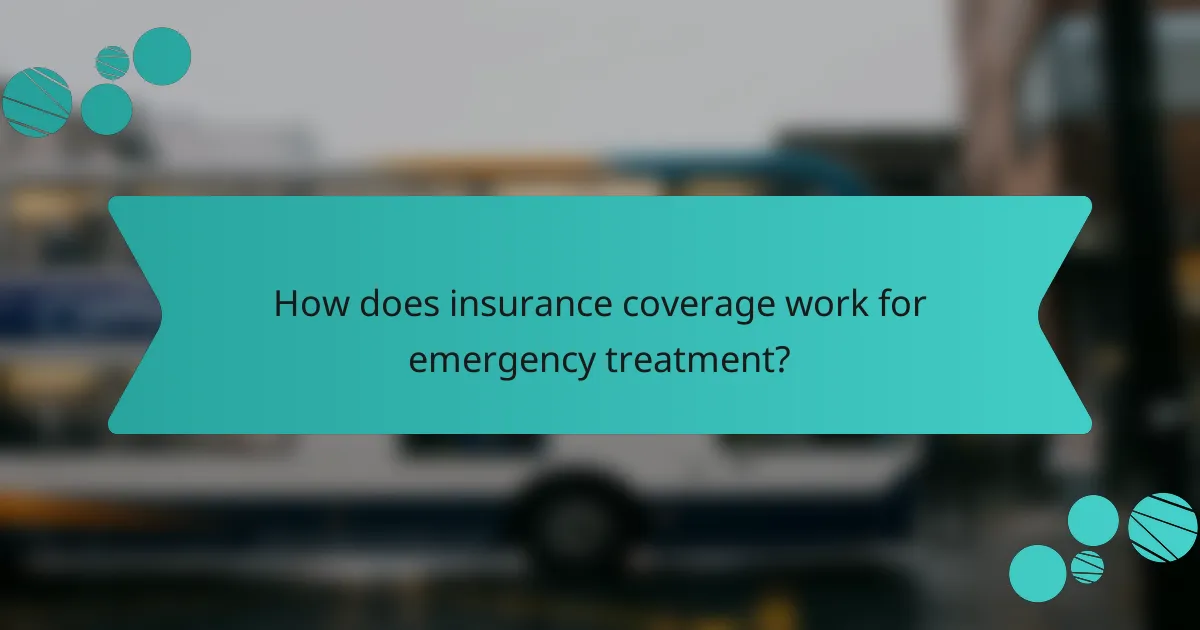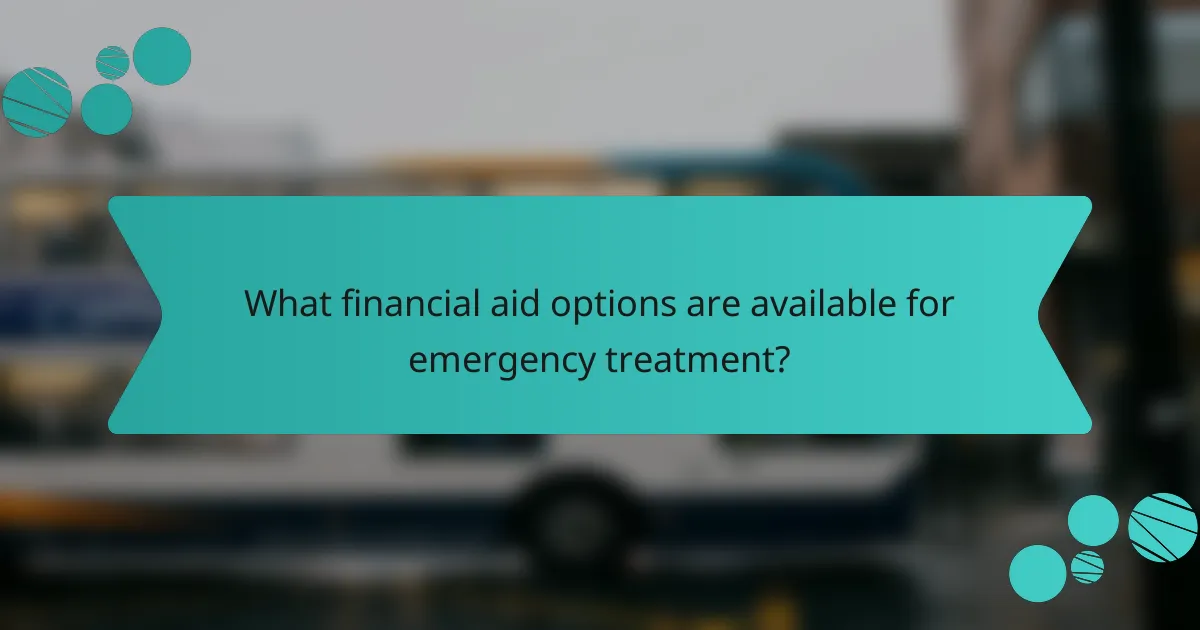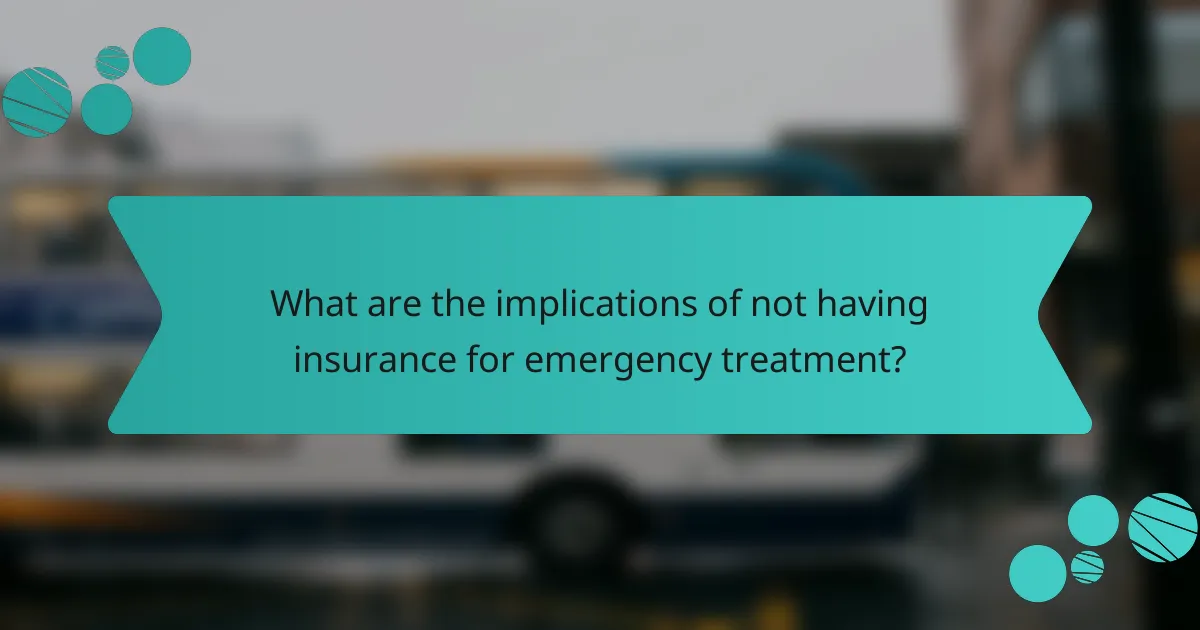Emergency treatment can lead to significant financial implications, influenced by the type of service, location, and insurance coverage. While Canada’s publicly funded healthcare system provides a safety net, patients may still face out-of-pocket expenses for certain treatments. Understanding your insurance policy is essential, as it determines your financial responsibility during emergencies. Additionally, various financial aid options are available to help mitigate unexpected medical costs, including government assistance and payment plans from healthcare providers.

What are the costs of emergency treatment in Canada?
The costs of emergency treatment in Canada can vary significantly based on the type of service required, location, and whether the patient has insurance coverage. Generally, Canadians benefit from a publicly funded healthcare system, but there are still out-of-pocket expenses for certain services and treatments.
Average costs for emergency room visits
The average cost for an emergency room visit in Canada can range from CAD 150 to CAD 500, depending on the complexity of the case and the province. For minor issues, the costs may be on the lower end, while serious conditions requiring extensive evaluation or treatment can push costs higher.
Patients should be aware that while emergency services are covered under provincial health plans, additional fees for specific services or treatments may apply. It’s advisable to check with local health authorities for detailed information on coverage.
Costs for ambulance services
Ambulance services in Canada typically cost between CAD 300 and CAD 1,000, depending on the distance traveled and the level of care provided during transport. Many provinces have a fee structure that varies based on the type of ambulance used, such as basic or advanced life support.
Insurance coverage for ambulance services can differ widely. Some provincial health plans cover a portion of the costs, while private insurance may cover the full amount. It’s important to verify your coverage before an emergency arises.
Specialized treatment costs
Specialized treatments, such as surgeries or advanced diagnostics, can incur significant costs, often ranging from CAD 1,000 to CAD 10,000 or more, depending on the procedure. These costs can vary based on the facility and the specific treatment required.
In many cases, specialized treatments may not be fully covered by provincial health insurance, leading to additional out-of-pocket expenses. Patients should consult with their healthcare provider and insurance company to understand potential costs and coverage options before proceeding with specialized care.

How does insurance coverage work for emergency treatment?
Insurance coverage for emergency treatment typically involves a range of policies that dictate how much of the medical costs will be paid by the insurer. Understanding your specific plan is crucial, as it can significantly impact your financial responsibility during a medical emergency.
Types of insurance plans accepted
Emergency treatment facilities generally accept various types of insurance plans, including employer-sponsored health insurance, individual plans, and government programs like Medicare and Medicaid. Each plan may have different networks of providers, so it’s essential to verify whether your insurance is accepted at the facility you visit.
Some facilities may also accept short-term or supplemental insurance plans, which can help cover additional costs not included in primary insurance. Always check with the provider beforehand to avoid unexpected expenses.
Coverage limits for emergency services
Most insurance plans have specific coverage limits for emergency services, which can vary widely. For example, some plans may cover 100% of the costs after a deductible is met, while others may only cover a percentage, leaving you responsible for the remainder.
It’s important to review your policy documents to understand these limits, as well as any exclusions that may apply to certain types of emergency care. Knowing these details can help you make informed decisions during a crisis.
Out-of-pocket expenses
Out-of-pocket expenses for emergency treatment can include deductibles, copayments, and coinsurance, which can add up quickly. Depending on your plan, you might pay a flat fee for emergency room visits or a percentage of the total bill.
To minimize out-of-pocket costs, consider using in-network providers whenever possible, as they typically have negotiated rates with insurance companies. Additionally, keep track of your medical expenses to ensure you are billed correctly and to facilitate any claims you may need to file.

What financial aid options are available for emergency treatment?
Various financial aid options exist for emergency treatment, helping to alleviate the burden of unexpected medical costs. These options include government assistance programs, support from non-profit organizations, and payment plans offered by hospitals.
Government assistance programs
Government assistance programs can provide vital financial support for emergency medical treatment. In the U.S., programs like Medicaid and Medicare can cover a significant portion of emergency services for eligible individuals, particularly those with low income or specific disabilities.
Eligibility requirements vary by state, so it’s essential to check local regulations. Additionally, some countries offer national health services that cover emergency care costs, reducing out-of-pocket expenses for residents.
Non-profit organization support
Non-profit organizations often offer financial aid for emergency medical treatment, especially for specific conditions or populations. Organizations like the HealthWell Foundation or the Patient Advocate Foundation provide grants and assistance for those facing high medical bills.
To access these resources, individuals typically need to demonstrate financial need and provide documentation of their medical situation. Researching local non-profits can uncover additional support tailored to specific health issues or demographics.
Payment plans offered by hospitals
Many hospitals offer payment plans to help patients manage the costs of emergency treatment. These plans allow individuals to pay their bills in installments, making it easier to handle large expenses over time.
When considering a payment plan, inquire about interest rates, terms, and any potential fees. It’s advisable to negotiate terms that fit your financial situation and to ensure you understand the total cost before agreeing to a plan.

What are the implications of not having insurance for emergency treatment?
Not having insurance for emergency treatment can lead to significant financial burdens, as individuals may face high out-of-pocket costs for medical services. Without coverage, the risk of accumulating substantial debt from medical bills increases, making it essential to understand the potential consequences.
Potential debt from medical bills
Emergency treatment can be costly, often ranging from hundreds to thousands of dollars depending on the severity of the condition and the required services. For those without insurance, these expenses must be paid out-of-pocket, which can quickly lead to overwhelming debt. Many hospitals require payment plans or upfront payments, leaving uninsured patients in a precarious financial situation.
Individuals may also face additional charges for follow-up care, medications, or specialist consultations, further increasing their financial liability. It is crucial to be aware of the potential for accumulating debt and to explore options like negotiating bills or seeking financial assistance from hospitals.
Impact on credit score
Unpaid medical bills can negatively affect your credit score, as healthcare providers may report delinquent accounts to credit bureaus. A lower credit score can hinder future financial opportunities, such as securing loans or mortgages, and may lead to higher interest rates. Even if a bill is eventually paid, the impact on credit can linger for years.
To mitigate this risk, it is advisable to communicate with healthcare providers about payment options and to prioritize paying off debts promptly. Setting up a budget to manage medical expenses can also help prevent financial strain and protect your credit standing.

How to choose the right insurance for emergency care?
Selecting the right insurance for emergency care involves understanding your coverage options, costs, and the specific needs of your situation. Prioritize plans that offer comprehensive emergency services, low out-of-pocket expenses, and a network of accessible providers.
Factors to consider when selecting a plan
When choosing an insurance plan for emergency care, consider the premium costs, deductibles, and co-pays associated with emergency services. Look for plans that have a low deductible and reasonable co-pays to minimize your financial burden during an emergency.
Evaluate the network of hospitals and emergency care facilities included in the plan. Ensure that local hospitals and urgent care centers are covered to avoid unexpected out-of-network charges. Additionally, check if the plan covers ambulance services, which can be a significant expense in emergencies.
Comparing different insurance providers
To effectively compare insurance providers, review their coverage options, customer service ratings, and claims processes. Look for reviews and testimonials from current policyholders to gauge satisfaction and reliability. Consider using online comparison tools to streamline this process.
Pay attention to the specific terms of emergency coverage, such as whether pre-authorization is required for certain services. Some providers may offer better rates but have stricter rules, which could complicate access to care when you need it most. Always read the fine print to understand what is and isn’t covered in emergencies.

What are the trends in emergency treatment costs in Canada?
Emergency treatment costs in Canada have been rising steadily, influenced by factors such as increased demand, advancements in medical technology, and inflation. Patients can expect to pay varying amounts depending on the nature of the emergency and the specific services required.
Cost implications of emergency treatment
The cost implications of emergency treatment can vary widely, often ranging from hundreds to thousands of Canadian dollars. Factors influencing these costs include the type of treatment, location, and whether the patient has insurance coverage. For example, a visit to an emergency room can cost between CAD 500 and CAD 2,000 depending on the complexity of care needed.
Patients should be aware that additional services, such as imaging or specialist consultations, can significantly increase overall expenses. Understanding these potential costs is crucial for making informed decisions during a medical emergency.
Insurance coverage for emergency treatment
Insurance coverage for emergency treatment in Canada typically depends on the type of plan a patient has. Most provincial health plans cover basic emergency services, but private insurance may be necessary for additional treatments or out-of-province care. Patients should review their insurance policies to understand what is covered and any potential out-of-pocket expenses.
It’s important to note that some services, such as ambulance transport, may not be fully covered by provincial health insurance, leading to additional charges. Patients should check with their insurance provider to clarify coverage details before an emergency arises.
Financial aid options for emergency treatment
Financial aid options for emergency treatment in Canada include government assistance programs, non-profit organizations, and payment plans offered by healthcare providers. Patients facing high costs may qualify for financial assistance based on income or specific circumstances, such as being uninsured or underinsured.
Additionally, some hospitals have financial counselors who can help patients navigate payment options and apply for aid. Seeking assistance early can alleviate financial stress and ensure that necessary care is received without delay.
